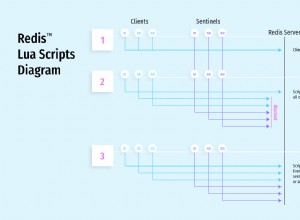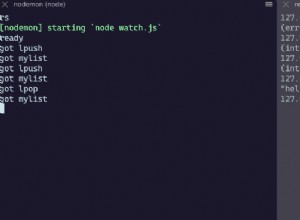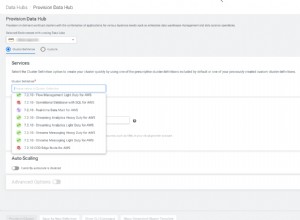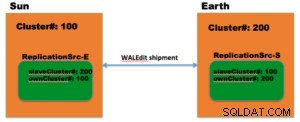Ако използвате Stackechange.Redis, можете да използвате методите List на неговия API. Ето една наивна реализация на IList, използваща списък на redis за съхраняване на елементите.
Надяваме се, че може да ви помогне да разберете някои от методите на API на списъка:
public class RedisList<T> : IList<T>
{
private static ConnectionMultiplexer _cnn;
private string key;
public RedisList(string key)
{
this.key = key;
_cnn = ConnectionMultiplexer.Connect("localhost");
}
private IDatabase GetRedisDb()
{
return _cnn.GetDatabase();
}
private string Serialize(object obj)
{
return JsonConvert.SerializeObject(obj);
}
private T Deserialize<T>(string serialized)
{
return JsonConvert.DeserializeObject<T>(serialized);
}
public void Insert(int index, T item)
{
var db = GetRedisDb();
var before = db.ListGetByIndex(key, index);
db.ListInsertBefore(key, before, Serialize(item));
}
public void RemoveAt(int index)
{
var db = GetRedisDb();
var value = db.ListGetByIndex(key, index);
if (!value.IsNull)
{
db.ListRemove(key, value);
}
}
public T this[int index]
{
get
{
var value = GetRedisDb().ListGetByIndex(key, index);
return Deserialize<T>(value.ToString());
}
set
{
Insert(index, value);
}
}
public void Add(T item)
{
GetRedisDb().ListRightPush(key, Serialize(item));
}
public void Clear()
{
GetRedisDb().KeyDelete(key);
}
public bool Contains(T item)
{
for (int i = 0; i < Count; i++)
{
if (GetRedisDb().ListGetByIndex(key, i).ToString().Equals(Serialize(item)))
{
return true;
}
}
return false;
}
public void CopyTo(T[] array, int arrayIndex)
{
GetRedisDb().ListRange(key).CopyTo(array, arrayIndex);
}
public int IndexOf(T item)
{
for (int i = 0; i < Count; i++)
{
if (GetRedisDb().ListGetByIndex(key, i).ToString().Equals(Serialize(item)))
{
return i;
}
}
return -1;
}
public int Count
{
get { return (int)GetRedisDb().ListLength(key); }
}
public bool IsReadOnly
{
get { return false; }
}
public bool Remove(T item)
{
return GetRedisDb().ListRemove(key, Serialize(item)) > 0;
}
public IEnumerator<T> GetEnumerator()
{
for (int i = 0; i < this.Count; i++)
{
yield return Deserialize<T>(GetRedisDb().ListGetByIndex(key, i).ToString());
}
}
System.Collections.IEnumerator System.Collections.IEnumerable.GetEnumerator()
{
for (int i = 0; i < this.Count; i++)
{
yield return Deserialize<T>(GetRedisDb().ListGetByIndex(key, i).ToString());
}
}
}
Обърнете внимание на използването на Newtonsoft.Json за сериализацията. Ще ви трябват следните пакети nu-get:
Install-Package Newtonsoft.Json
Install-Package StackExchange.Redis
След като прочетох въпроса и коментарите си, тъй като искате да получите достъп до елементи по ключ, мисля, че търсите Redis хешове, които са карти, съставени от полета, свързани със стойности.
Така че можете да имате Redis ключ за хеш, съдържащ всичките ви клиенти, като всеки от тях е стойност, свързана с поле. Можете да изберете CustomerId като поле, за да можете след това да получите клиент по неговия идентификатор в O(1).
Мисля, че внедряването на IDictionary е добър начин да го видите как работи. Така че клас RedisDictionary, подобен на RedisList, но използването на Redis Hash, може да бъде:
public class RedisDictionary<TKey, TValue> : IDictionary<TKey, TValue>
{
private static ConnectionMultiplexer _cnn;
private string _redisKey;
public RedisDictionary(string redisKey)
{
_redisKey = redisKey;
_cnn = ConnectionMultiplexer.Connect("localhost");
}
private IDatabase GetRedisDb()
{
return _cnn.GetDatabase();
}
private string Serialize(object obj)
{
return JsonConvert.SerializeObject(obj);
}
private T Deserialize<T>(string serialized)
{
return JsonConvert.DeserializeObject<T>(serialized);
}
public void Add(TKey key, TValue value)
{
GetRedisDb().HashSet(_redisKey, Serialize(key), Serialize(value));
}
public bool ContainsKey(TKey key)
{
return GetRedisDb().HashExists(_redisKey, Serialize(key));
}
public bool Remove(TKey key)
{
return GetRedisDb().HashDelete(_redisKey, Serialize(key));
}
public bool TryGetValue(TKey key, out TValue value)
{
var redisValue = GetRedisDb().HashGet(_redisKey, Serialize(key));
if (redisValue.IsNull)
{
value = default(TValue);
return false;
}
value = Deserialize<TValue>(redisValue.ToString());
return true;
}
public ICollection<TValue> Values
{
get { return new Collection<TValue>(GetRedisDb().HashValues(_redisKey).Select(h => Deserialize<TValue>(h.ToString())).ToList()); }
}
public ICollection<TKey> Keys
{
get { return new Collection<TKey>(GetRedisDb().HashKeys(_redisKey).Select(h => Deserialize<TKey>(h.ToString())).ToList()); }
}
public TValue this[TKey key]
{
get
{
var redisValue = GetRedisDb().HashGet(_redisKey, Serialize(key));
return redisValue.IsNull ? default(TValue) : Deserialize<TValue>(redisValue.ToString());
}
set
{
Add(key, value);
}
}
public void Add(KeyValuePair<TKey, TValue> item)
{
Add(item.Key, item.Value);
}
public void Clear()
{
GetRedisDb().KeyDelete(_redisKey);
}
public bool Contains(KeyValuePair<TKey, TValue> item)
{
return GetRedisDb().HashExists(_redisKey, Serialize(item.Key));
}
public void CopyTo(KeyValuePair<TKey, TValue>[] array, int arrayIndex)
{
GetRedisDb().HashGetAll(_redisKey).CopyTo(array, arrayIndex);
}
public int Count
{
get { return (int)GetRedisDb().HashLength(_redisKey); }
}
public bool IsReadOnly
{
get { return false; }
}
public bool Remove(KeyValuePair<TKey, TValue> item)
{
return Remove(item.Key);
}
public IEnumerator<KeyValuePair<TKey, TValue>> GetEnumerator()
{
var db = GetRedisDb();
foreach (var hashKey in db.HashKeys(_redisKey))
{
var redisValue = db.HashGet(_redisKey, hashKey);
yield return new KeyValuePair<TKey, TValue>(Deserialize<TKey>(hashKey.ToString()), Deserialize<TValue>(redisValue.ToString()));
}
}
System.Collections.IEnumerator System.Collections.IEnumerable.GetEnumerator()
{
yield return GetEnumerator();
}
public void AddMultiple(IEnumerable<KeyValuePair<TKey, TValue>> items)
{
GetRedisDb()
.HashSet(_redisKey, items.Select(i => new HashEntry(Serialize(i.Key), Serialize(i.Value))).ToArray());
}
}
И ето няколко примера за използването му:
// Insert customers to the cache
var customers = new RedisDictionary<int, Customer>("customers");
customers.Add(100, new Customer() { Id = 100, Name = "John" });
customers.Add(200, new Customer() { Id = 200, Name = "Peter" });
// Or if you have a list of customers retrieved from DB:
IList<Customer> customerListFromDb;
customers.AddMultiple(customerListFromDb.ToDictionary(k => k.Id));
// Query a customer by its id
var customers = new RedisDictionary<int, Customer>("customers");
Customer customer100 = customers[100];
Актуализация (октомври 2015 г.)
По-добра реализация на тези колекции може да се намери в библиотеката CachingFramework.Redis.
Ето кода.




